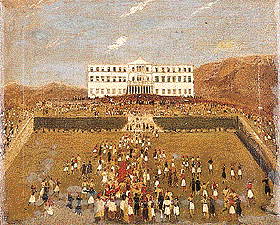On the 3rd of September 1843, the garrison of Athens, supported by the majority of the Hellenic people, revolted against the
Monarchy, requesting a constitution. The main reasons behind the revolt were the autocratic reign of King Otho and his breaking
of the decision taken by the National Assemblies (1821-1827). The final agreement of Otho with the demands of the rebels signaled
the end of the Absolute Monarchy and the beginning of the new era of the Constitutional Monarchy.
Scene from the Uprising of 3 September 1843. Oil-painting.


